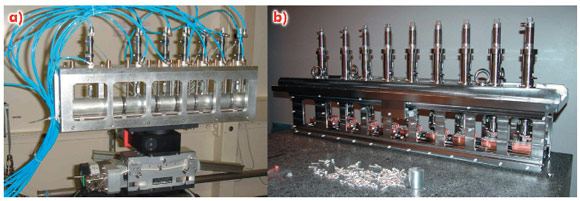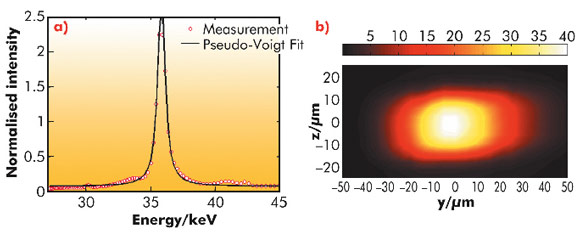- Home
- Users & Science
- Scientific Documentation
- ESRF Highlights
- ESRF Highlights 2010
- Enabling technologies
- X-ray transfocators: tuneable focussing devices based on compound refractive lenses
X-ray transfocators: tuneable focussing devices based on compound refractive lenses
Since their development almost 15 years ago, X-ray refractive lenses have rapidly gained renown and they are now in common use on synchrotron beamlines. Compared to other focussing elements, refractive lenses present several attractive features, being simple to align and relatively insensitive to misorientations. Since refractive lenses are in-line optics, they are more stable with respect to angular vibrations in comparison to deflecting optics. They can be adapted to very high X-ray energies by modifying their composition and number, and can be inserted and removed from the beam to allow fast switching of the beam size. As the index of refraction for refractive lenses is extremely close to 1 and energy dependent, a substantial, well-defined number of lenses are necessary to focus X-rays of a given energy at a given distance. For this reason, transfocators – systems with a tuneable number of lenses – have been proposed to provide permanent energy and focal length tunability [1-2]. The transfocators are comprised of several cartridges containing different numbers of lenses, such that the focal distance can be continuously adjusted by insertion or retraction of one or more of the lens cartridges.
 |
|
Fig. 142: a) The IAT installed on the ID11 beamline and b) the IVT during construction (right). |
An in-air transfocator (IAT) [1] has been in operation at the ID11 beamline for almost 3 years (Figure 142a). Based on the success of the IAT, in-vacuum transfocators (IVT) have now been installed at ID11 and ID15 (Figure 142b). The IVTs are water cooled to allow use in the white beam. They are installed closer to the X-ray source (~30 m) where they capture a larger proportion of the diverging X-ray beam (Figure 143). The variable focal length of the transfocator focussed beam means that it can be exploited at all of the beamline experimental stations leading to enormous flux gains (up to 105) with respect to an unfocussed beam.
Transfocators are very flexible and have been used in several different configurations. They can be used as standalone focussing devices in the monochromatic beam, giving micrometre spot sizes.
 |
|
Fig. 144: a) Measured spectrum through a 10 x 10 µm2 pinhole of the beam optimised for 35.5 keV. b) Spatial distribution of the flux at 35.500 ± 0.005 keV perpendicular to the beam at the focus. |
Also the transfocators can act as pre-focussing devices to be used in conjunction with a downstream micro- or nano-focussing element. As a single optical device in the white beam, the IVT can act as a fundamentally new kind of monochromator, delivering impressive flux in a ~1% band pass beam (a factor of 75 with respect to the ~10-3 band pass beam when used in conjunction with a double Laue monochromator) (Figure 144). The energy selectivity of the IVT comes from the chromatic nature of the focussing; with a relatively short focal length the depth of focus is sufficiently short that only a narrow band pass is focussed at a given longitudinal point. At the focal point, this leads to an increase in the flux of 2 orders of magnitude at the selected energy with respect to the rest of the spectrum. Such ultra intense, stable and focussed beams with moderate band pass can be useful for several applications in which high energy resolution is not necessary, such as scattering from liquids or poorly crystalline materials. The band pass of this monochromator is well matched to exploit the spectrum of the harmonic peaks of an undulator insertion device at a third generation storage ring.
Authors
A. Snigirev, G.B.M. Vaughan, J.P. Wright, V. Honkimaki and I. Snigireva
ESRF
References
[1] A. Snigirev, I. Snigireva, G.B.M. Vaughan, J. Wright, M. Rossat, A. Bytchkov and C. Curfs, Journal of Physics, Conference Series, 186, 012073 (2009).
[2] G.B.M. Vaughan, J.P. Wright, A. Bytchkov, M. Rossat, H. Gleyzolle, I. Snigireva and A. Snigirev, J. of Synchrotron Rad., accepted (2011), doi:10.1107/S0909049510044365.




